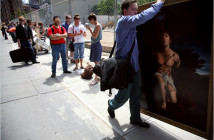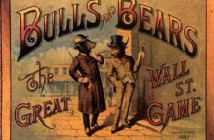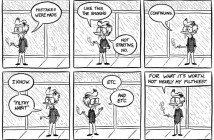THE DUMBING DOWN OF ART
I l-o-o-o-o-ve art. I love thinking about it, talking about it, looking at it, smelling it, love the cozy vibe of my studio, and that I don‘t have to wear mascara there. When I am in art-mode I feel taller, lighter, more balanced; I feel like a freaking rock star. Not only do I love making the art but I really breathe better, maybe breathe through my eyeballs, when I’m looking at art.
This is especially true when I don’t understand what I’m looking at, when I’m annoyed or irritated by the art. Instead of walking away angry I think, “interesting.” Problems arise when I am in the presence of “control,” when I sense that the artist is a person who needs certainty in their lives and has not made room for that crazy out-on-a-cliff feeling that is the foundation of fresh art. The viewer should not be able to understand at first glance, should not be simple-mindedly delighted by everyday materials used cleverly but should be given a brain full of images seeking words to express them. Uncertainty is where good art lives.
There is obviously a great deal of difference between the concerns of viewers and the concerns of artists. Viewers may be making a living off the art, maybe being moved by it or of late, being entertained by it. We have become an audience that does not really want to work hard. We like special effects, flashing screens, things moving fast, exploding, morphing, changing colors, shiny things that sway, the swagger of masculine materials and the swooshing sounds of feminine ones. The viewer only cares about the finished product but for the artist making the work, it is about learning how to make more work. Whether it soars or lies down like a greasy pancake, the artist has no choice but to push ahead towards that elusive vision in their heads of some personal epiphany. Sadly, if the art is flawed then the artist frequently feels that they are flawed too, so the idea of stepping out, of doing iffy, subversive, risky stuff can be just too much. The very idea of self is at stake, so it is much easier to repeat past successes, to not rock the boat, to make work that the market will understand. Even better, make work that is about them, the artist, about their inner cosmos, about their lifestyle, about their musings, about their pending celebrity. Unfortunately the artist is the last person to be able to judge whether they are being authentic or not and the end result is often one of easy dismissal by the viewer. Whose fault is this? Has the art dumbed down because the artist’s scope is so narrow or is the viewer jaded, uneducated, out of touch, in fear of introspection?
In his book, “Amusing Ourselves to Death,” Neil Postman makes reference to Roland Barthes’ use of the word “myth.” Postman claims that television has achieved the status of myth, a way of “understanding the world that is not problematic, that we are not fully conscious of, that seems in a word, natural.” He claims that television has become our culture. We have accepted its truths, assume it has a voice and forget that it is primarily entertainment. Postman’s book was published in 1985 but imagine what he would have to say about us in 2009? How much of our lives are about being entertained and do we know the difference?
On Facebook there is an option offered for people to “poke” each other. In this context I find the opportunity to poke my friends really offensive (and would eject anyone from my circle of friends if they poked me. I’m just sayin’.) But in the world of art one must somehow poke the viewer, jolt them out of their everyday mindset and derail their thoughts into some deeper place. If the commodity art marketplace demands that when the audience steps into a white cube they experience riding in a roller coaster, sit through a 30-minute black-and-white film of waves crashing, get shocked by pictures of sci-fi genitalia or my special fave, a shark in a tank, how far is art from being a theme park? The audience needs to do nada, just show up, leave the brains at the door.
In my desperation to immerse in the sublime I trekked to Italy and dragged my butt through more duomos and fortress towns than I want to admit, but here‘s what dawned on me: great art is not about the artist, it is about something bigger than ourselves. Granted that in 2009 we are rarely subsidized by the church to depict the Bible but the artists who painted in the service of the church were negotiating between themselves and an idea, a subject and a technique.
Why can’t that apply in the 21st century? Who said making art is easy? Well, making dumb art is easy, a sure thing, but where is the fun in that?



